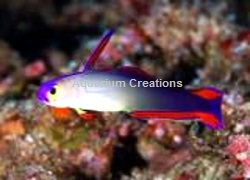Purple Firefish
Nemateleotris decora
 YouTube Video of the Purple Firefish
YouTube Video of the Purple Firefish
Identification:
The Purple Firefish from Maldives is a magnificent little fish that's perfect for reef tanks. These fish have a light lavender colored body with purple markings on their face and towards their tailfin, along with dark red and purple colored fins. The Purple Firefish also has an elongated first dorsal spine that "jumps" up and down. These little fish have lots of personality and should be kept in a tank with lots of rockwork. The Purple Firefish likes lots of crevices, caves, and overhangs where they can "hang" in place. Purple Firefish do best when kept in pairs of 2 or more.
Tank Recommendations:
e the best possible aquarium the Firefish requires a 20-gallon or larger system with moderate lighting conditions and a moderate current passing over the live rock "reef." When putting together a tank containing firefish, remember when stressed they will try to jump out of your aquarium. As such, house the Firefish in an aquarium system with a lid.
Food and diet:
Feed frozen crustaceans of suitable size, such as Artemia or copepods (i.e., red plankton), finely chopped mysis or krill, and fish roe are good staple foods. Flake foods will also be taken provided they are broken into small-enough pieces and preferably presented in midwater, as firefishes sometimes have difficulty learning to feed from the surface.
Level of Care:
Easy
Acclimaton Time:
1+ hours
Reef Compatibility:
Reef or Community Aquarium
Approximate Purchase Size:
Small: 1" to 1-1/2"; Medium: 1-1/2" to 2"; Large: 2" to 3"
|
Small $29.99
Medium $32.99
Large $34.99
|
|

 YouTube Video of the Purple Firefish
YouTube Video of the Purple Firefish